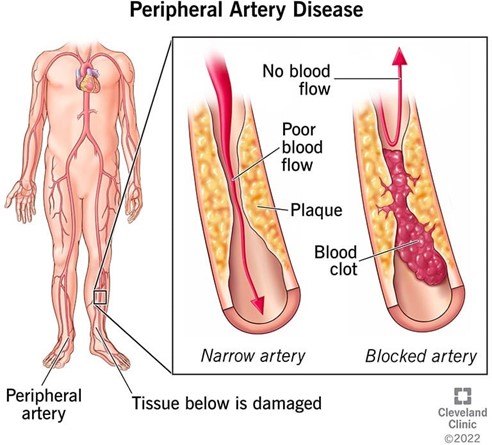A nurse is assessing a male client who has advanced peripheral artery disease (PAD). Which of the following findings should the nurse expect?
Thin, pliable toenails
Hairy legs
Leg pain at rest
Flushed, warm legs
The Correct Answer is C
feet or toes that occurs at night and is not relieved by rest.

Nursing Test Bank
Naxlex Comprehensive Predictor Exams
Related Questions
Correct Answer is C
Explanation
Impaired tissue perfusion is a nursing diagnosis that indicates a decrease in oxygen and nutrient delivery to the tissues, resulting in cellular dysfunction and potential tissue damage or necrosis. It is the priority nursing diagnosis for a client who has varicose veins with ulcerations and lower extremity edema, as these are signs of chronic venous insufficiency, which is a condition in which the veins in the legs fail to return blood to the heart effectively, causing blood to pool and stagnate in the lower extremities. This leads to increased venous pressure, inflammation, and impaired wound healing, which can cause skin breakdown, infection, and tissue necrosis. The nurse should monitor the client's vital signs, peripheral pulses, capillary refill, skin color, temperature, and sensation, and implement interventions to improve venous return and prevent further complications, such as elevating the legs, applying compression stockings, encouraging ambulation, administering medications, and providing wound care.
Alteration in body image. This is a nursing diagnosis that indicates a negative perception or dissatisfaction with one's physical appearance or function. It may be applicable for a client who has varicose veins with ulcerations and lower extremity edema, as these may affect their self-esteem and social interactions. However, it is not the priority nursing diagnosis for this client, as it does not pose an immediate threat to their health or safety.
Alteration in activity tolerance. This is a nursing diagnosis that indicates a decrease in the ability to perform physical activities without experiencing fatigue, dyspnea, or other symptoms. It may be applicable for a client who has varicose veins with ulcerations and lower extremity edema, as these may limit their mobility and endurance. However, it is not the priority nursing diagnosis for this client, as it does not pose an immediate threat to their health or safety.
Impaired skin integrity. This is a nursing diagnosis that indicates a disruption or damage to the epidermis or dermis layers of the skin. It is applicable for a client who has varicose veins with ulcerations and lower extremity edema, as these can cause skin breakdown and infection. However, it is not the priority nursing diagnosis for this client, as it is a consequence of impaired tissue perfusion, which is the underlying problem that needs to be addressed first.
Correct Answer is C
Explanation
Obtaining a pair of slipper socks for the client is a simple and safe way to provide warmth and insulation to the feet, which can improve blood flow and comfort.
Placing a moist heating pad under the client's feet is not recommended, as it can cause burns, vasodilation, or increased fluid loss, which can worsen the condition.
Increasing the client's oral fluid intake is not relevant, as it does not affect the temperature or circulation of the feet.
Rubbing the client's feet briskly for several minutes is not advisable, as it can cause trauma, inflammation, or ulceration to the fragile skin and tissues of the feet.
Obtaining a pair of slipper socks for the client is a simple and safe way to provide warmth and insulation to the feet, which can improve blood flow and comfort.
Placing a moist heating pad under the client's feet is not recommended, as it can cause burns, vasodilation, or increased fluid loss, which can worsen the condition.
Increasing the client's oral fluid intake is not relevant, as it does not affect the temperature or circulation of the feet.
Rubbing the client's feet briskly for several minutes is not advisable, as it can cause trauma, inflammation, or ulceration to the fragile skin and tissues of the feet.
Whether you are a student looking to ace your exams or a practicing nurse seeking to enhance your expertise , our nursing education contents will empower you with the confidence and competence to make a difference in the lives of patients and become a respected leader in the healthcare field.
Visit Naxlex, invest in your future and unlock endless possibilities with our unparalleled nursing education contents today
Report Wrong Answer on the Current Question
Do you disagree with the answer? If yes, what is your expected answer? Explain.
Kindly be descriptive with the issue you are facing.
